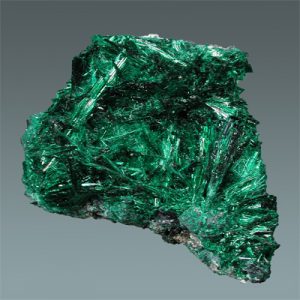Brochantite (incl.)
Brochantite is a common copper sulfate hydroxide mineral that is additional. It typically types as acicular or crystals which are fibrous into randomly arranged coatings and tufts. It is also rarely found as acicular inclusions in Quartz. Brochantite might also be located as pseudomorphs after Azurite, Malachite and Langite or altered to Chrysocolla. Brochantite is found in tones of emerald-green, blackish pale or green green with vitreous luster.
Brochantite was named in 1824 by Serve-Dieu Abailard “Armand” Lévy in honor of André-Jean-François-Marie Brochant de Villiers (1772-1840), French geologist and mineralogist.
Brochantite distribution: In Russia, from the Mednorudyanskoye copper deposit, near Nizhni Tagil, and at Gumeshevsk, southwest of Yekaterinburg (Sverdlovsk), Ural Mountains. At Băiţa Mining District (Baita Bihor; Rézbánya), Romania. From Rosas and Sa Duchessa, Sardinia, Italy. In Germany, at the Clara mine, near Oberwolfach, Ebony Forest. In England, numerous occurrences in Cornwall, and at Roughton Gill, Cumbria. From Tsumeb, Namibia. At Aïn-Barbar, Constantine, Algeria. In Australia, at Broken Hill, New South Wales. From many occurrences in Chile, as at Chuquicamata and Collahuasi, Antofagasta; from Potrerillos, Atacama; and at Challacollo, Tarapacá. In america, in Arizona, large crystals from Bisbee, Cochise County, and at the Mammoth-St. Anthony mine, Tiger, Pinal County; in the Mammoth mine, Tintic, Juab County, Utah; at Bingham, Socorro County, New Mexico; from the Cerro Gordo mine, Inyo County, California; into the Douglas Hill and Mason Pass mines, Yerington district, Lyon County, Nevada. A number of other localities are known.
| Chemical Formula: | Cu4(SO4)(OH)6 |
| Copper Sulfate Hydroxide | |
| Molecular Weight: | 452.29 gm |
| Composition: | Copper | 56.20 % | Cu | 70.35 % | CuO |
| Hydrogen | 1.34 % | H | 11.95 % | H2O | |
| Sulfur | 7.09 % | S | 17.70 % | SO3 | |
| Oxygen | 35.37 % | O | |||
| 100.00 % | 100.00 % | = TOTAL OXIDE |
| Crystallography: | Monoclinic – Prismatic |
| Crystal Habit: | Crystals are typically thick prismatic to acicular, elongated along [001] or [010], to 5 cm; may be flattened [001]; about 40 forms known; in aggregates, druses, crusts, also massive, granular. |
| Twinning: | On {100} with composition surface {100}, common. The twinned crystals are often symmetrical and pseudo-orthorhombic in appearance. |
| Cleavage: | Perfect on {100} |
| Fracture: | Irregular/Uneven, Conchoidal |
| Tenacity: | Brittle |
| Moh’s Hardness: | 3.5 – 4.0 |
| Density: | 3.97 (g/cm3) |
| Luminescence: | None |
| Radioactivity: | Not Radioactive |
| Other: | Soluble in acids |
| Color: | Emerald-green, blackish green, pale green; bluish green in transmitted light |
| Transparency: | Transparent to translucent |
| Luster: | Vitreous, somewhat pearly on cleavages |
| Refractive Index: | 1.728 – 1.800 Biaxial ( – ) |
| Birefringence: | 0.072 |
| Dispersion: | Medium; r < v |
| Pleochroism: | Weak; Slight in shades of bluish green |


